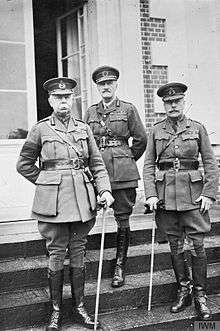Herbert Lawrence
| Sir Herbert Lawrence | |
|---|---|
 General Sir Herbert Lawrence (centre) with General Sir Herbert Plumer and Field Marshal Sir Douglas Haig in 1918 | |
| Born |
8 August 1861 London, England |
| Died |
17 January 1943 (aged 81) Little Berkhamsted, England |
| Allegiance | United Kingdom |
| Service/ | British Army |
| Years of service |
1882–1903 1914–1919 |
| Rank | General |
| Commands held |
66th (2nd East Lancashire) Division (1917) 71st Division (1916–17) 52nd (Lowland) Infantry Division (1915–16) 127th (Manchester) Brigade (1915) |
| Battles/wars |
Second Boer War First World War |
| Awards |
Knight Grand Cross of the Order of the Bath Grand Officer of the Legion of Honour (France) Croix de guerre (France) Grand Cross of the Order of the Crown (Belgium) Croix de guerre (Belgium) Army Distinguished Service Medal (United States) Grand Officer of the Order of Karađorđe's Star (Serbia) Grand Officer of the Military Order of Aviz (Portugal) |
| Relations | John Lawrence, 1st Baron Lawrence (father) |
| Other work | Chairman of Glyn, Mills & Co. Bank |
General Sir Herbert Alexander Lawrence, GCB (8 August 1861 – 17 January 1943) was a general in the British Army, a banker and a businessman.
Lawrence was born in London on 8 August 1861, the son of Sir John Laird Mair Lawrence, later Lord Lawrence and the Governor-General of India, and his wife Harriette Katherine Hamilton. He was educated at Harrow School and the Royal Military College, Sandhurst.[1]
Commissioned into the 17th Lancers in India in 1882, he entered the Staff College, Camberley in 1894. After graduating in 1896 he was appointed a staff captain (intelligence) at the War Office. During the Second Boer War he served on the intelligence staff of Sir John French's cavalry division with Douglas Haig and was promoted lieutenant colonel in the 16th Lancers.
He resigned his commission in 1903 and became a city banker. He was also a director of the Midland Railway.
When the First World War started he was recalled for army service and became general staff officer of the 2nd Yeomanry Division, serving in Egypt and at Gallipoli. In June 1915 he was given the command of the 127th (Manchester) Brigade, part of the 42nd (East Lancs) Territorial Division.
At Gallipoli he commanded the 52nd (Lowland) Infantry Division and during the evacuation at the end of 1915 he oversaw the withdrawal at Cape Helles beach. In 1916 he returned to Egypt and achieved success at the Battle of Romani, but asked to be relieved of his command later in the year and was transferred to the 71st Home Service Division in England. In 1917 he was in France as commander of the 66th (2nd East Lancashire) Division, with whom he remained until made chief intelligence officer on Haig’s staff in January 1918. He then took over from Sir Launcelot Kiggell as Chief of Staff in France and was promoted full general.
Lawrence was made Knight Commander of the Order of the Bath in 1917 and Knight Grand Cross of the Order of the Bath in 1926. He also received, as well as other overseas honours, the Croix de guerre and was made a Grand Officer of the Legion of Honour in 1919. In 1919 he was given the Colonelcy of the 21st (Empress of India's) Lancers, transferring after amalgamation to the 17th/21st Lancers, a position he held until 1938. From 1925 to 1932 he was also Colonel of the Manchester Regiment.[2]
After the war he was appointed as a member of the Royal Commission on the Coal Industry in 1925,[3] a trustee of the Imperial War Graves Commission in 1926 and a governor of Wellington College. He became chairman of Vickers in 1926 and of Glyn’s Bank in 1934. He was also chairman of several other banks and a director of a number of companies.
He died in 1943 and was buried at Seal, near Sevenoaks, Kent. He had married Isabel Mary Mills, the daughter of Charles William Mills, 2nd Baron Hillingdon in Sevenoaks in 1892. Their two sons were both killed in action during the First World War.
References
- ↑ "Herbert Lawrence". RBS Heritage Hub. Retrieved 10 February 2017.
- ↑ "Manchester Regiment". regiments.org. Archived from the original on 16 December 2007. Retrieved 5 February 2017.
- ↑ "No. 33082". The London Gazette. 8 September 1925. p. 5911.